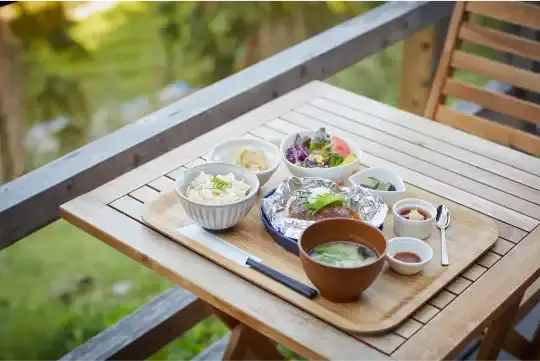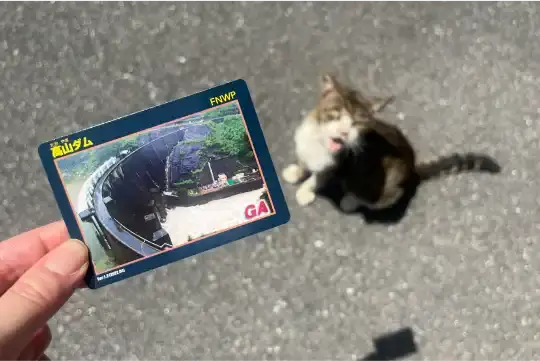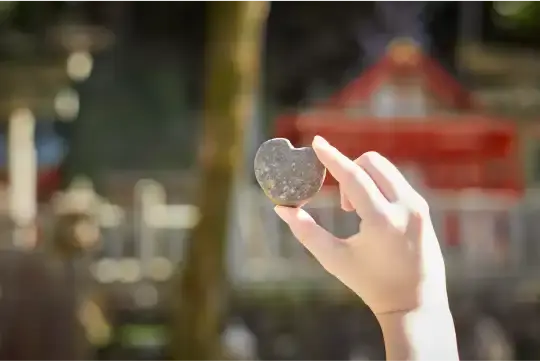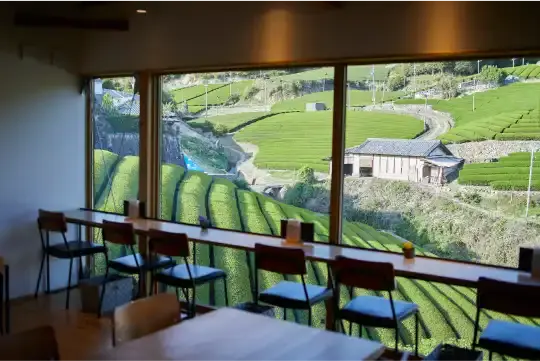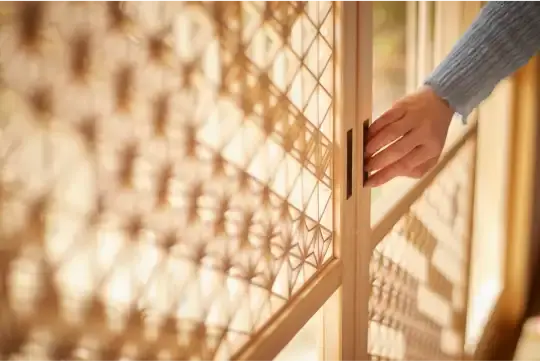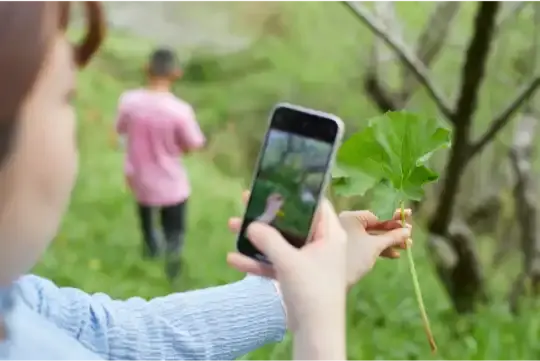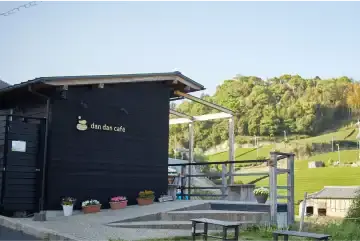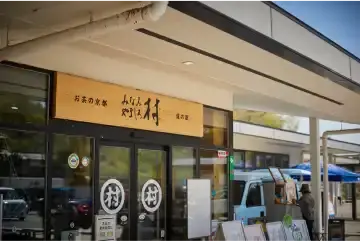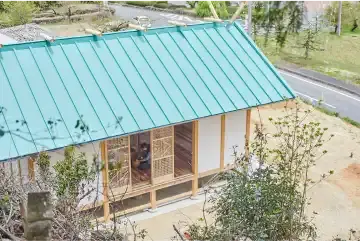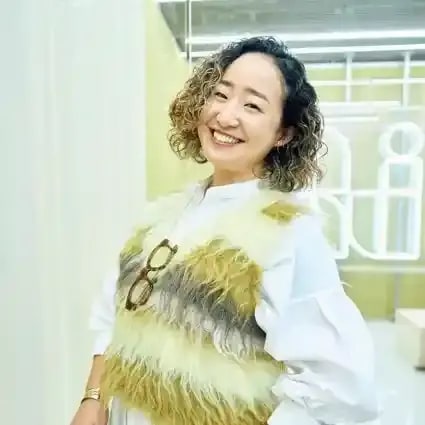A trip to experience amazing safflower dyeing in Minamiyamashiro, Kyoto.

As I got older, I became more interested in Japanese history and traditional culture. One day, while I was talking with my senpai (older colleague) who had the same interests as me, I learned from her that apparently, the only Ubai craftsperson in Japan is in Tsukigase, Nara, and he offers safflower dyeing experience.
I asked, "The only one in Japan?! Also, what is Ubai?" She replied, "You're curious, aren't you? Why don't we go together then?" We both got excited and decided to go there over the weekend.
I asked, "The only one in Japan?! Also, what is Ubai?" She replied, "You're curious, aren't you? Why don't we go together then?" We both got excited and decided to go there over the weekend.
Enjoying Kyoto’s green tea with sweets while marveling at tea fields.
It would take about two hours by car from Osaka to Tsukigase. It wasn’t that far, so a day trip would have been enough if we were only after the experience. But we wanted to enjoy other things, too, so we decided to stay the night. As we heard that the safflower dyeing experience takes about five hours, we made a reservation for the second day of our trip. We would just spend the first day enjoying Kyoto's tea culture.


First, we headed to dan dan cafë in Wazuka-cho. We saw an online review saying that the lunch there was available in limited quantity, so we had to arrive early. When we sat on the terrace where a pleasant breeze was blowing, the panoramic view of the beautiful tea fields in front of us took our breath away! As we were admiring the view, we noticed black areas in the fields, so we asked the shop staff about them. "Those are Kabuse tea. You see, tea becomes sweeter when it is covered to protect it from the sun," she said. We finished our homemade healthy lunch while talking about how Kabuse tea is made.
We got to talk to the owners of the café, who happen to be siblings, and we told them what we thought of the taste of their food. We said, "I read that this matcha gelato uses twice the amount of matcha powder that is usually used!" and "No wonder it's so rich and creamy!" In response, the brother explained, "We use only tea leaves picked in spring from the plantation of my classmate. Since we don't blend tea leaves, the taste may vary depending on the year." We left the cafe with a smile and told each other, "We should come back here to try next year’s matcha."
A relaxing time appreciating the everyday landscape.

We decided to keep on driving and stop at places we wanted to see. We figured that as long as we got back to the hotel before dark, then we should be fine. When we entered Minamiyamashiro Village, my senpai, who loves watching TV dramas, told me that there might be a bridge there that has been used as a filming location, so we headed to Koiji Bridge that she found on the map. She exclaimed, "This scenery looks familiar to me!" I couldn’t believe what she was saying, but her excitement made me feel happy, too.

After enjoying a playful moment on the riverbank, we went shopping at a Michi-no-Eki (roadside station) and then checked in at the hotel.
"It was a great day. I tasted Kyoto green tea and had a peaceful time admiring the tranquil scenery," I told my senpai. As I looked back on the day, I quickly fell asleep thanks to the comfortable bedding.
"It was a great day. I tasted Kyoto green tea and had a peaceful time admiring the tranquil scenery," I told my senpai. As I looked back on the day, I quickly fell asleep thanks to the comfortable bedding.
The joy of dyeing textile with Ubai and safflower by myself.

The next morning, after warming our bodies and minds with tea-flavored congee for breakfast at the Michi-no-Eki, we set off for the safflower and Ubai dyeing experience. My senpai gave an explanation on the way to our destination.
First of all, Ubai is smoked dried plums. Ubai was brought to Japan as a medicine about 1,400 years ago and has been used as mordant (an auxiliary agent that helps dyes develop colors, and sets the colors on fabric) for safflower dyes and cosmetic lipsticks.
As my senpai was saying, "Our destination, the Baikoan, is apparently the last Ubai workshop in Japan and it has been making Ubai for 700 years," we arrived in Tsukigase. Nakanishi, the Ubai craftsman, welcomed us.
First of all, Ubai is smoked dried plums. Ubai was brought to Japan as a medicine about 1,400 years ago and has been used as mordant (an auxiliary agent that helps dyes develop colors, and sets the colors on fabric) for safflower dyes and cosmetic lipsticks.
As my senpai was saying, "Our destination, the Baikoan, is apparently the last Ubai workshop in Japan and it has been making Ubai for 700 years," we arrived in Tsukigase. Nakanishi, the Ubai craftsman, welcomed us.


"We wanted to reproduce the kind of work environment that surrounded artisans 700 years ago, so we incorporated the traditional architectural style into this workshop," said Nakanishi. The workshop itself was full of charms and that got us more excited.
This dyeing experience uses only natural materials: safflower, lye, and Ubai. The highlight was spending time and effort to reproduce the traditional colors.
This dyeing experience uses only natural materials: safflower, lye, and Ubai. The highlight was spending time and effort to reproduce the traditional colors.

The first thing we did was wash off the unwanted yellow pigments from safflower as only the red pigment, which accounted for only 1% of the pigments contained in safflower, would be used for dyeing. We rubbed the petals in cold water for about 90 minutes. "We also hold workshops that will let you experience the entire dyeing process, from growing safflower to the actual dyeing, so we have begun growing our own safflower. We want to increase the yield in the future. We're also making lipstick using Ubai. It's almost finished. Would you like to look at it later?" said Nakanishi.
His stories about Ubai and safflower were fascinating, and we enjoyed our pleasant conversation while working. "Perhaps his ancestors also were engaged in a conversation while working," I wondered.
His stories about Ubai and safflower were fascinating, and we enjoyed our pleasant conversation while working. "Perhaps his ancestors also were engaged in a conversation while working," I wondered.

After lunch, Nakanishi asked, "There is Japanese butterbur growing behind the house. Would you like to go and pick some?" We unexpectedly went into the grass and picked some butterbur plants. "So, this is butterbur. I think this is the first time I've seen it." "I picked so many!" We chatted along as we enjoyed our unexpected interaction with nature.


We went back to the workshop and after the process of adding lye and Ubai juice, we reached the climax of dyeing. We were amazed at what we had made, saying, "The color slightly differs depending on the textile" and "It's amazing that natural materials can so beautifully dye textiles."
"Getting hands-on experience is more interesting than just watching and listening. It takes time and effort, but it would make me really happy if you rediscover the charms of Japanese traditions," said Nakanishi. The words of the craftsman who has inherited the traditions and is trying to pass them on to the next generations carry weight. Now, every time I touch the beautiful red color that I dyed with my own hands, I will remember this place.
"Getting hands-on experience is more interesting than just watching and listening. It takes time and effort, but it would make me really happy if you rediscover the charms of Japanese traditions," said Nakanishi. The words of the craftsman who has inherited the traditions and is trying to pass them on to the next generations carry weight. Now, every time I touch the beautiful red color that I dyed with my own hands, I will remember this place.














